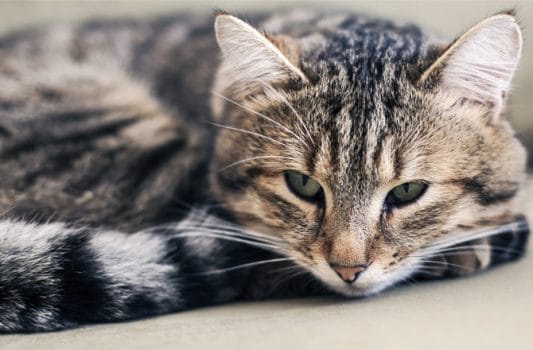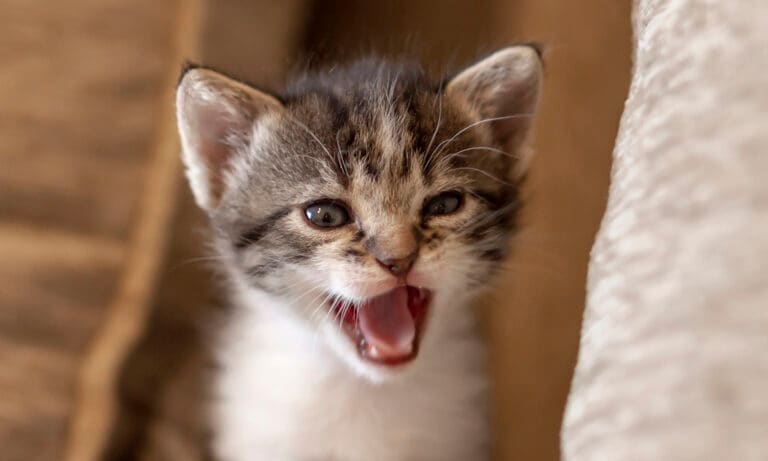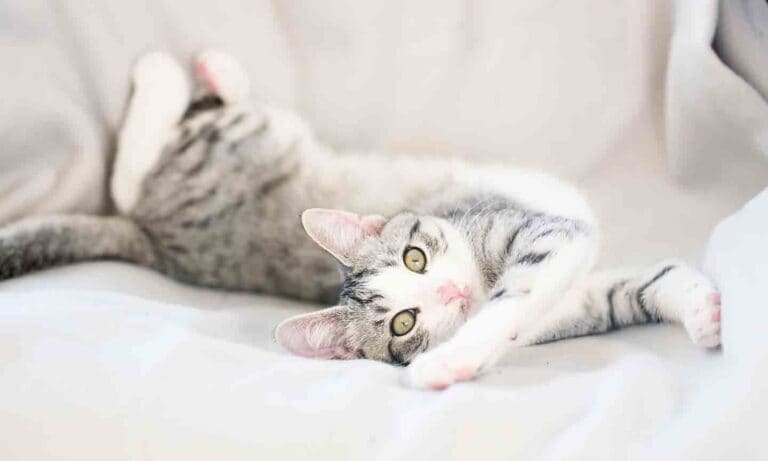While decoding cat speak can feel impossible at times (Why did he just twitch his tail? What’s that glare about?) cats are actually quite good at giving us clues into what they’re thinking and feeling.
“It can be difficult to understand cat behavior or moods, but with some basic knowledge of feline natural history, practice acknowledging body language, and personal experience, owners can become aware of what their cat may be communicating,” said Melissa J. Sigala, behavior and training specialist for the spcaLA.
Here are some common behaviors your cat is likely to exhibit, and what it probably means when he’s doing them.
1. The Mood: Scared
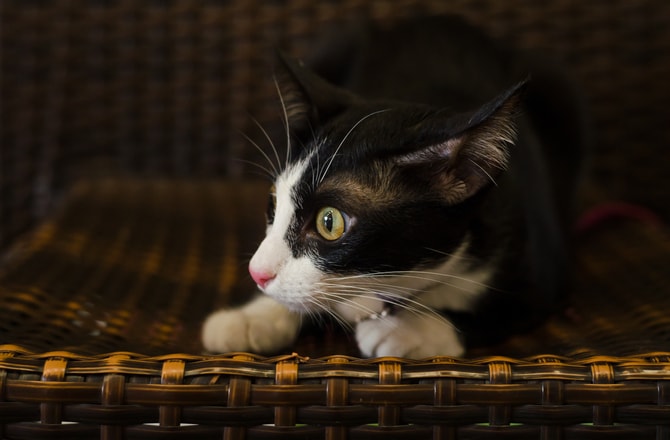
What it looks like: Cats who are scared may hunker down with their ears back, vocalize their fear through hisses or growls, or can even run away and hide. “His eyes may become wide with dilated pupils, and his hackles may erect while he stands on his toes with his back arched,” says Sigala.
A scared cat may also try to look as small and non-threatening as possible, says certified cat behavior consultant Pam Johnson-Bennet. “He may perch with his paws tucked underneath and tail wrapped closely around his body and he may also avoid looking at your as a way of saying he’d rather not engage,” she says. “A scared cat may also not engage in typical daily activities like eating, using the litter box or playing.”
2. The Mood: Happy/Content
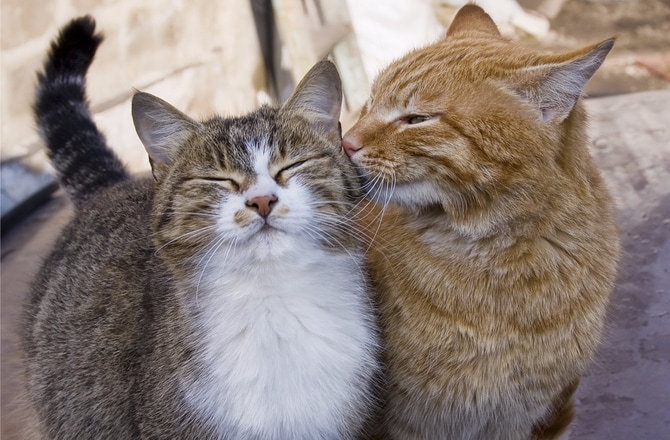
What it looks like: Happy cats often have soft or calm body language, including raised tails that are curved at the tip, upright (but not stiff) ears, and soft eyes with slow blinks.
“Pupils may dilate when aroused — like with a favorite treat or playtime — and you may also hear low purring,” says Sigala. A content cat may also knead around or directly on you with her paws. “Cats usually groom each other to show affection and helpfulness, so grooming their owner may be a way of showing affection,” Sigala says.
3. The Mood: Insecure/Anxious

What it looks like: Anxious cats may bite or scratch inanimate objects like blankets and shoes. They may also chase and bite their own tails or have an inability to stay still.
“A cat may bite his owner’s hands and feet when the owner has not solicited any interaction,” Sigala says. “Plus his tail will likely be low or tucked in and he may hide when guests are around or walk along the edges of the room rather than through the middle.”
Also look for an anxious cat to exhibit stress-relieving behaviors like grooming, says Johnson-Bennet. “While cats are known for their fastidious grooming habits, an anxious cat may take that grooming behavior to another level and over-groom.” An anxious cat may also display changes in everyday habits like eating, cat litter box use or scratching, warns Johnson-Bennet, so be on the lookout for those signs.
4. The Mood: Agitated/Annoyed

What it looks like: Fast wagging tails and loud and long vocalizations are all signs of agitation or annoyance, says Sigala. “Your cat may move away or leave altogether and he may also swat with his paws and give a ‘warning bite’ to make the point that he’s annoyed.” This bite won’t usually break the skin.
A thumping tail is also a safe bet your cat is agitated about something, adds Johnson-Bennet. “His ear position will communicate his mood, too, as the pinnae (or external part of the ear) will be sideways or even in full airplane wing position.”
5. The Mood: Aggressive
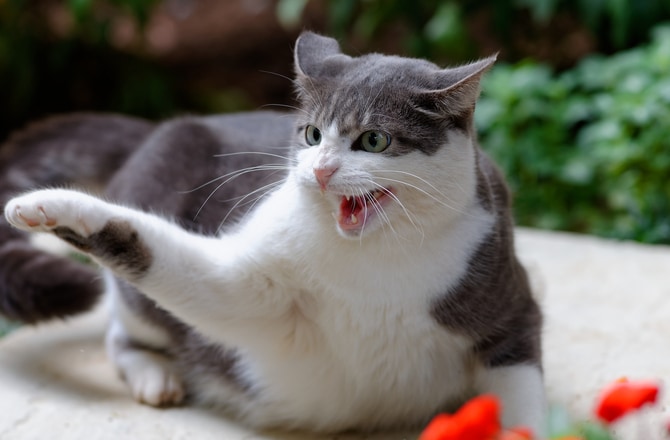
What it looks like: Aggressive cats are probably the easiest to spot. Constricted pupils, growls, lunges and swats are all signs of aggression, as well as a stiff body with erect hackles, bared teeth or ears pulled back. “This can lead to fighting with another cat or an attack towards an owner,” says Sigala.
6. The Mood: Hungry/Needy

What it looks like: A cat who is hungry or would like something else from its owner may wake you from your sleep or become very vocal with repeated, high-pitched, short meows, although Sigala warns that every cat has different meows for their owner. “He may also sit near his feeding area or walk you to the item needed, like his cat food, water or litter box.”
7. The Mood: Affectionate

What it looks like: Cats show that they’re in an affectionate mood in a variety of ways, many of which we tend to miss because they aren’t generally as overt as cuddling, says Johnson-Bennet.
“Affection can be displayed by head bunting, social grooming, slow eye blinks, purring and just being physically close,” she says. “The cat may choose to recline next to you, but with his back facing you. It may seem insulting to us that the cat would turn his back, but it’s actually quite a compliment and display of trust.”
Cats show that they’re in an affectionate mood in a variety of ways, many of which we tend to miss because they aren’t generally as overt as cuddling, says Johnson-Bennet.
“Affection can be displayed by head bunting, social grooming, slow eye blinks, purring and just being physically close,” she says. “The cat may choose to recline next to you, but with his back facing you. It may seem insulting to us that the cat would turn his back, but it’s actually quite a compliment and display of trust.”
By Cheryl Lock
Share:
